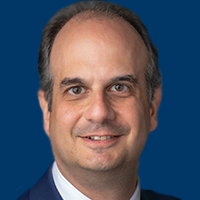Dr Leal on a PD-L1 Subgroup Analysis of the LUNAR Trial in mNSCLC
Ticiana Leal, MD, discusses the rationale for and findings from a PD-L1 subgroup analysis of the phase 3 LUNAR trial in patients with metastatic non–small cell lung cancer.
Ticiana Leal, MD, associate professor, director, Thoracic Medical Oncology Program, Department of Hematology and Medical Oncology, Emory University School of Medicine, discusses the rationale for and findings from a PD-L1 subgroup analysis of the phase 3 LUNAR trial (NCT02973789) in patients with metastatic non–small cell lung cancer (mNSCLC), which she presented at the 2023 IASLC World Conference on Lung Cancer.
The LUNAR trial investigated tumor treating fields (TTFields) plus standard-of-care (SOC) immune checkpoint inhibitors or docetaxel in patients with mNSCLC who had progressed on platinum chemotherapy. The initial findings from this trial showed that TTFields plus SOC extended overall survival (OS) vs SOC alone, with a median OS of 13.2 months (95% CI, 10.3-15.5) vs 9.9 months (95% CI, 8.1-11.5; [HR, 0.74; 95% CI, 0.56-0.98; P = .035]). Additionally, in patients who received an immune checkpoint inhibitor, the median OS was 18.5 months (95% CI, 10.6-30.3) in the TTFields arm vs 10.8 months (95% CI, 8.2-18.4) in the SOC arm (HR, 0.63; 95% CI, 0.41-0.96; P = .030).
PD-L1 is a predictive biomarker used to select patients who are most likely to respond to immune checkpoint inhibitor therapy, Leal says. In the global LUNAR trial, PD-L1 reporting was optional, and 83% of patients in the overall trial population in the United States who received an immune checkpoint inhibitor had a PD-L1 tumor proportion score available, Leal notes. This PD-L1 subset analysis aimed to investigate the correlation between PD-L1 expression and outcomes with TTFields plus immune checkpoint inhibitors, Leal explains.
The patient characteristics were balanced between the PD-L1–positive and PD-L1–negative subgroups, according to Leal. Importantly, the patients with PD-L1–positive disease who received TTFields plus an immune checkpoint inhibitor achieved an OS benefit compared with those who received an immune checkpoint inhibitor alone, Leal emphasizes. The median OS in the PD-L1–positive TTFields arm was 23.6 months (95% CI, 7.7-not reached) vs 10.5 months (95% CI, 7.5-26.6) in the PD-L1–positive immune checkpoint inhibitor monotherapy arm.



